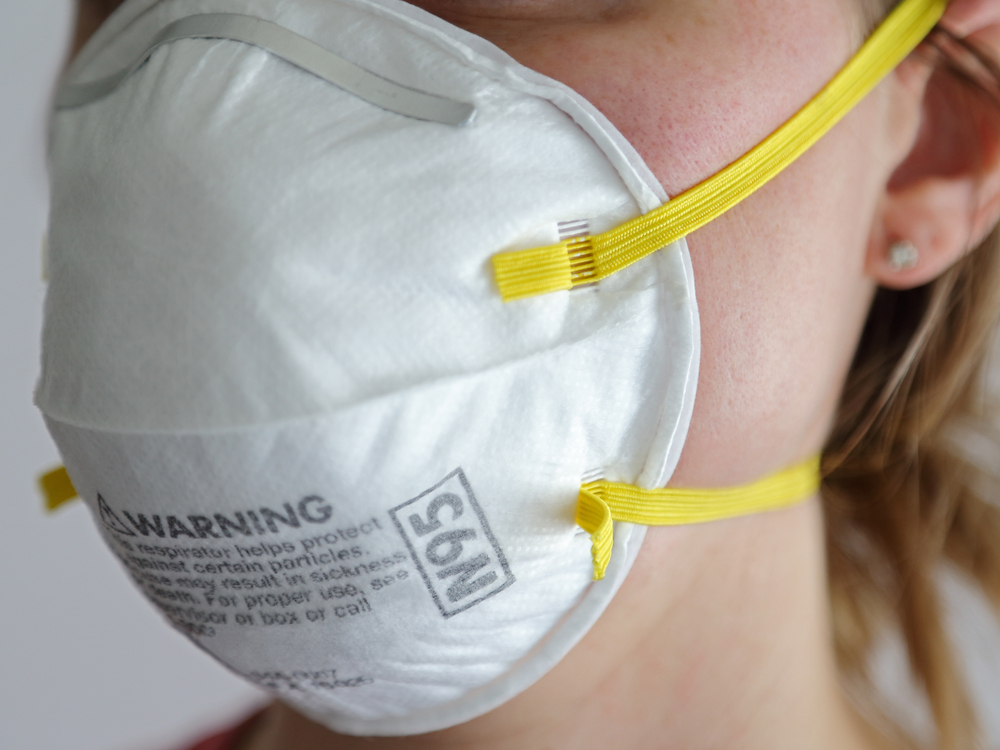All About Masks: Information, Guidance and Resources
SARS-CoV-2 is a highly contagious airborne virus which can cause severe long-term health problems even after seemingly “mild” infections. Know the facts about how it spreads, and how you can protect yourself and others.
Clean air: The first line of defense
COVID-19 infection is mainly caused by inhaling aerosols containing the virus which are exhaled by an infected person (“source”), even if they are vaccinated and have no symptoms. Masking and ventilation, which filter and clean the air we breathe, are our first lines of defense against infections like COVID-19, flu, measles and tuberculosis, which spread through the air.
Why should I mask?
The virus in these aerosols is most concentrated in the air around the source, but they also float and spread like smoke and linger in indoor air for hours, especially in poorly ventilated spaces, even if the source has left the room. Social distancing helps, but when you’re indoors, or in outdoor crowds, ultimately everyone is breathing in some of each other’s air.
COVID-19 continues to circulate at variable but impactful levels, and it continues to sicken, disable and kill people of all ages. The likelihood of encountering a contagious person is high, and it’s not always apparent.
COVID-19 is contagious for a few days before symptoms start, and about half of all infections are spread by people before they realize they are sick or who have mild or no symptoms. COVID tests can be helpful, since positive results are usually reliable, but false negative results are common especially during the first few days of symptoms.
Can’t I just vax and relax?
Vaccination is one of the most important layers of protection, but vaccines alone are not protective enough. They reduce the chance of severe symptoms and death at the time of initial infection, but they do not reliably prevent infection and transmission to others. Their immunity wears off, and they may be less effective against the constantly mutating new variants. They importantly reduce, though do not eliminate, the chance of developing Long COVID, which can disrupt the immune and blood clotting systems and cause diseases of the heart, brain, lungs and other organs, as well as disability, and death after the initial infection. The risk of Long COVIDgoes up with each reinfection.
Are some masks better than others?
All masks are not created equal. Any mask is better than no mask – without any mask, it can take only seconds to minutes to get infected, even when socially distanced – but fit and filtration make a big difference in how well your mask will protect you and others.
Two-way masking is the most effective – when everyone present is wearing well-fitted, high-filtering respirator-grade masks such as N95, KN95, KF94, FFP2 or elastomerics, and wearing them over the nose and mouth correctly and consistently, the chance of infection is nearly entirely eliminated. When two-way masking isn’t possible, choosing the best available product for yourself will still greatly reduce your risk.
A well-fitted mask is one that forms a good seal all the way around the nose and mouth of the wearer without any gaps. Air should pass through the electrostatic particle filtering material, and not leak inward or outward through gaps, holes, or loose connections between the wearer’s skin and the seal of the mask. Respirator-grade masks are superior to surgical and cloth masks, and those with headloops (N95, elastomeric) provide a superior seal to those with earloops (KN95, KF94, some FFP2).
Masks that don’t filter well, like cloth masks, or those that fit loosely and leak, like unmodified surgical masks, are less protective against getting infected or spreading infection to others. And wearing any kind of mask below the nose offers no protection at all to the wearer.
DOs and DON’Ts
DOs:
- Do choose a certified (NIOSH-approved in the USA) respirator-grade (N95, KN95, KF94, FFP2 or elastomeric) mask. If these are not available to you, choose a multi-layer mask with a high quality filter that fits you well. You can use a mask brace or mask fitter to improve the seal.
- Do handle your mask by the straps with clean hands, and avoid touching the inside of your mask.
- Do consider shaving or closely trimming a beard. Some beard styles may cause a gap between your mask and your face which can allow unfiltered air to get inside the mask. If you need to keep your beard, use a mask fitter or brace to press the mask firmly against your face.
- Do keep your mask on, covering your nose and mouth at all times when indoors or in outdoor crowds with others.
- Do go outside and physically distance when taking off your mask to eat and drink.
- Do minimize the amount of time you are unmasked if you must eat indoors:
- choose the best ventilated location available, near an open window if possible
- sit separately from others
- inhale with your mask in place, exhale while lifting your mask as little as possible, and hold your breath when taking a bite or sipping fluids (through a straw if possible)
- quickly restore your mask once food/drink is in your mouth
- avoid touching the inside of the mask
But be aware that this is not foolproof and you can still get infected!
DON’Ts:
- Don’t wear a mask that fits loosely and leaves gaps, that doesn’t cover your nose and mouth, or is too uncomfortable to keep on.
- Don’t wear a mask that is damp, soiled, damaged, has stretched out bands, or has become harder to breathe through.
- Don’t remove your mask while speaking, even if distanced – that’s when you emit even more aerosols!
- Don’t crowd or lean in close to people to speak, or sit very close to others.
- Don’t turn up the music above conversation level.
How to Up Your Mask Game
Aim for the best possible protection.
Choose a mask with the best filtering efficiency available to you, and take steps to check and maximize the fit. Your mask should create a tight seal with no air leakage all around.
Do a user seal test on respirator-grade masks:
- Put on the mask. If there are two straps, make sure one strap is above your ears and one below.
- Mold the nosewire tightly against the bridge of your nose. Use the first two fingers of each hand on either side of your nose, and press in, working your way from your nose outward. Do not pinch the nosewire as this can cause a “leaky peak.” You may need to flatten the nosewire before putting on the mask.
- Check the seal:
- Cup your hands near the edges of the mask. Inhale sharply and hold your breath for a moment to make sure the mask collapses inward. Then exhale sharply and make sure it bulges outward and that you don’t feel a sensation of air leaking or coolness
- Cup your hands over the mask and inhale and exhale sharply, and see if you feel a sensation of air leaking or coolness.
- If you feel a leak around your nose, adjust the nosewire.
You may need to take it off and flatten it or round it around your thumb. KN95s have a sharp crease which always needs to be flattened before putting them on.
- If you feel a leak around the sides, adjust the straps and make sure the edges fit snugly against your face and that no hair or jewelry is interfering with the fit.
- After adjusting, if the mask is still leaking, try a different type.
Surgical masks are not designed to fit and seal well, but this can be improved:
- Devices like strap adjusters, earloop toggles, or an external mask brace can help seal the leaks. Avoid under-mask brackets as they can worsen the fit.
- The knot-and-tuck technique may improve the fit of surgical masks, but avoid crossing the earloops as this can worsen side gaps.
- If your eyeglasses are fogging or your eyes feel drier than normal when you wear the mask, you may still be having some upwards leakage of air when you breathe out. Facemask tape products can help.
For upgraded fit testing of respirator-grade masks:
- Use a qualitative fit test kit:
Commercial fit test kits include hoods, sweet (saccharine) or bitter (bitrex) solutions, and a nebulizer to spray the solutions through the hole in the hood, using specific, easy to follow steps. If you don’t taste the solution, your mask passes the fit test. If you do taste it, try to adjust the fit or try a different type.
- DIY your own qualitative fit test kit
- Quantitative fit testing uses a machine to measure respirator effectiveness.
For best filtering, choose the highest possible quality of material that has been designed for respiratory protection.
Ensure authenticity: Avoid fakes.
Add eye protection: Infection by particles entering the eyes is also possible anytime you are in a space that has airborne particles. Combine a mask with non-fogging goggles or other eye protection for improved safety. Even using prescription or non-prescription glasses provides some defense against infection.Face shields can provide partial eye protection and can help extend the life of a mask, but they do not block aerosols.
Mask Types, Ranked
Best
PAPR – Powered Air Purifying respirators.
- A PAPR consists of an enclosed headgear (half mask, mask or hood) with a fan, filter and power source.
- It pumps in filtered air for you to breathe.
- Some models also filter your exhaled air, but traditional PAPRs (e.g. 3M) may not have filtered exhalation valves. These models as-is will only protect you, but not others, but they can often be combined with another mask.
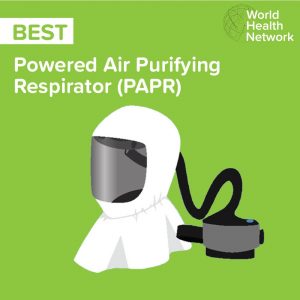
Top Quality
Elastomeric half facepiece or full facepiece reusable respirators.
- Full facepiece respirators also provide eye protection.
- Very protective for health care workers with heavy exposure to COVID-19, but anyone can wear these.
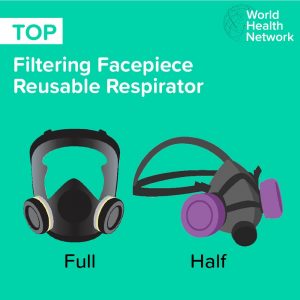
High-Quality Respirator-Grade Masks
- N95
- Elastomeric masks with a silicone seal
Mid Quality Respirator-Grade Masks
- KN95, KF94, or earloop FFP2 worn correctly

Good
Surgical masks of high quality (rated ASTM 3) WITH MODIFICATIONS
- According to CDC, surgical masks are only intended for droplet/splash protection. They are NOT classified as respiratory protection against aerosols and therefore are not generally adequate against COVID, though modifications can improve their protectiveness.
- The material filters very well, but they fit so loosely that they block less than 50% of aerosols.
- Knot-and-tuck technique or use of earloop toggles brings filtration efficiency up to ~75% .
- Sealing the leaks by adding a mask brace brings filtration efficiency up to ~90%.
- Avoid crossing the earloops or wearing a mask bracket underneath the mask as these may worsen fit.
Layering cloth and surgical masks in the right combination.
- Tight-fitting 3-ply 100% cotton mask with adjustable nose wire worn over an ASTM3 surgical mask, acting as a brace.
- Pros: Good in a pinch. Up to ~85 – 95% filtration efficiency.
- Cons: Harder to breathe; filtration varies with different products.
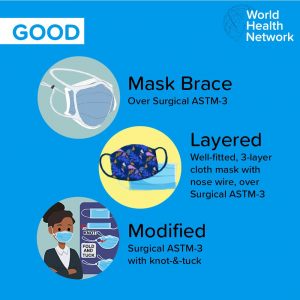
Fair
- Well-fitted 2-3 layer cotton mask with a filter pocket and a nose wire.
- Unmodified surgical mask.
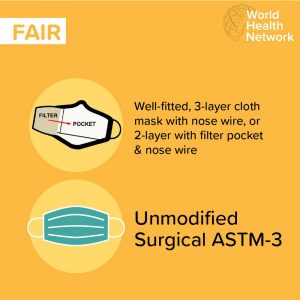
Poor (mostly decorative)
- Single layer cloth masks or gaiters, made of materials that don’t block the light.
- 2-3 ply cloth masks with no modifications: ~20–21% filtration efficiency.
- Valved masks (don’t protect others).
- Any product that fits loosely, leaving gaps.

How to Care for Your Masks
Respirator-grade masks can be reused if they are taken care of according to the following guidelines:
- Reuse only if they are clean and dry, with minimal wear and tear.
- Store used masks in a clean, sealable plastic bag at room temperature, and rotate them every 3-4 days.
- Handle your mask by the straps, with clean hands when putting it on, and clean your hands after storing or disposing of a used mask.
- For daily use, cycle between 5 – 7 (or more) masks. Label bags for each mask by the day of use and replace each mask in the labeled bag after each use, making a non-penetrating checkmark on the outside of the bag each time, to keep track of the number of times used.
- Most respirator-grade masks can be reused about five times, It is not recommended to use them for more than a total of about 40 hours.
- Inspect masks before reuse. Discard a mask if it is damaged, soiled, looking worn-out, or becoming more difficult to breathe through or to adjust due to changes in shape, loosened straps, etc.
- To dispose of masks, carefully fold them in half without shaking them out, with the inside surfaces touching each other, then cut the strings with scissors to prevent risks to wildlife.
- Dispose of masks carefully in a covered trash can, or place in a plastic bag first if only open receptacles are available, and keep out of reach of children or animals.
- Do not expose masks to excessive heat (hair dryers, microwaves, ovens)
- Do not clean masks with disinfectants, sanitizing wipes, bleach, alcohol, etc, and do not wash non-cloth respirators and surgical masks.
- Wash and fully dry cloth masks after every use, by machine if possible, in the warmest water and highest dryer setting for the fabric type, using laundry detergent or soap. Cloth masks can be machine washed with the rest of your laundry.
- Follow manufacturers’ care instructions for elastomerics or other reusables.
Resources
The World Health Network has no commercial interest in any referenced products or resources.
About Masks
Masks and respirators for prevention of respiratory infections: a state of the science review
CDC: Understanding the difference between surgical masks and respirators (new link)
Eyes can be infected by Covid-19: 4 things to know
Putting on and fit-checking a respirator-grade mask
Face mask fit modifications: mask braces and layering
How to Knot and Tuck Your Surgical Mask to Improve Fit
Mask Nerd Video: Layering and Mask Fitters (braces)
DIY How to do a Mask Fit Test at Home: Poor Man’s Fit Test
DIY Performing Respirator Fit Test Without a Commercial Kit (figure 2)
Facial Hairstyles and Respirator Fit (new link)
Where to Buy Authentic Masks and Accessories
EnvoMask Reusable Elastomeric N95 and N99 with soft gel seal and changeable filter
FloMask Reusable Elastomeric N95 with silcone seal and changeable filter
Adult and child sizes, ethnically inclusive high and low nosebridges for different face types.
SoftSeal disposable respirator-grade masks with silicone seal
Fix The Mask – Mask brace to improve surgical mask fit
MaskTite Antifogging Facemask Tape
Mask Quality Comparison
Mask Nerd: Mask Product Comparison Data – Look at Filtration Efficiency Column
Mask Fit Testing
Qualitative Fit Test Kits – Commercial
Qualitative Fit Test Kits – DIY
How to Spot Fakes
CDC: How to identify a NIOSH-approved N95
